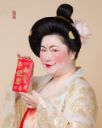Nitpicking
Early on in the rise of the Hanfu Movement, back in 2006, a picture was taken down on the Chinese government’s official website which showed Han Chinese wearing Hanfu, but with a crossed collar that crossed to the left. Hanfu enthusiasts contacted the relevant ministry and asked why this was so.[Cui 2016, p 22]
In fact, the “correct” form of Hanfu has a jiaoling youren 交领右衽, a crossed collar with a fold from the right.[Ling 2020] The ministry picked up on this quickly, and changed the picture.
Hanfu spans a large history, and it is sometimes traced back to the mythical Yellow Emperor 皇帝,[Ibid] who is said to be the forefather of all Han Chinese. From then on, Hanfu has developed numerous characteristics. Hanfu is said to be characterized by the right-folding collar we see here; a waist fastened with robes, thus without buttons; long robes and wide sleeves.[Ibid] The call for true Hanfu has been so large, that the Chinese website hanminzu.net, where the Hanfu Movement started to develop, listed the requirements for a true Hanfu seller:
1. Our businesses should insist on focusing on the importance of the benefit of the Han ethnicity.
2. Our businesses do certainly not engage in selling Qipao 旗袍, Magua 马褂, fake Tangzhuang 唐装 or any other clothing that has Qing Manchu or contemporary Manchu characteristics.
3. Our businesses’ products have to be made according to the correct designs of Hanfu.
4. Our businesses have a plight to promote Hanfu.
5. Our businesses will do all they can to act professionally.
6. Our businesses should help each other, and not have common strife. We hope our businesses have basic knowledge of Huaxia 华夏 culture and Huaxia 华夏 belief.[Cf]
Hanfu is often traced back to Chinese dynasties where Han Chinese were the ruling ethnicity, and where such characteristics of Hanfu are said to stem from. These dynasties include the Han dynasty (202BC-220AD), the Tang dynasty (618-907), and the Ming dynasty (1368-1644). Some enthusiasts are drawn more towards specific dynasties, while others believe Hanfu to be similar throughout all dynasties.
I thought of the Tang dynasty look because that was maybe the only dynasty in Chinese history that was relatively accepting of a plump or fuller look, said Zheng Qi, an 39-year-old internet sensation in the New York Times in 2018.[Buckley and Katrina Northrop 2018] Zheng Qi chose the Tang dynasty (618-907), deemed a cosmopolitan empire by many, due to the fact that it was more accepting of women with a fuller look.
However, the Tang dynasty was also an empire in which so-called Hufu 胡服, non-Han apparel, was very popular. The Tang dynasty, deemed the greatest Han Chinese dynasty by some, was ruled by a family of mixed descent with close ties to the people from the steppes in the northwest of China.[Chen 2019, p 146] The clothing during this dynasty was thus also influenced by the people of the steppes, and hufu was, in fact, a true craze during the Tang dynasty, with Han Chinese women wearing hufu.[Lewis 2012, p 96]
The Hanfu Movement’s rhetoric argues that members of the Han race all wore Hanfu throughout the dynasties, thus being linked to the greatness of the Han. However, there is no clear indication that there was such a thing as Hanfu. Instead, Hanfu as propagated by the contemporary Hanfu Movement is deemed an invented tradition [Carrico 2018], with scholar Zhang Xian 张跣 arguing that it was popularized by students through the internet, without thorough knowledge of Han Chinese clothing traditions.

